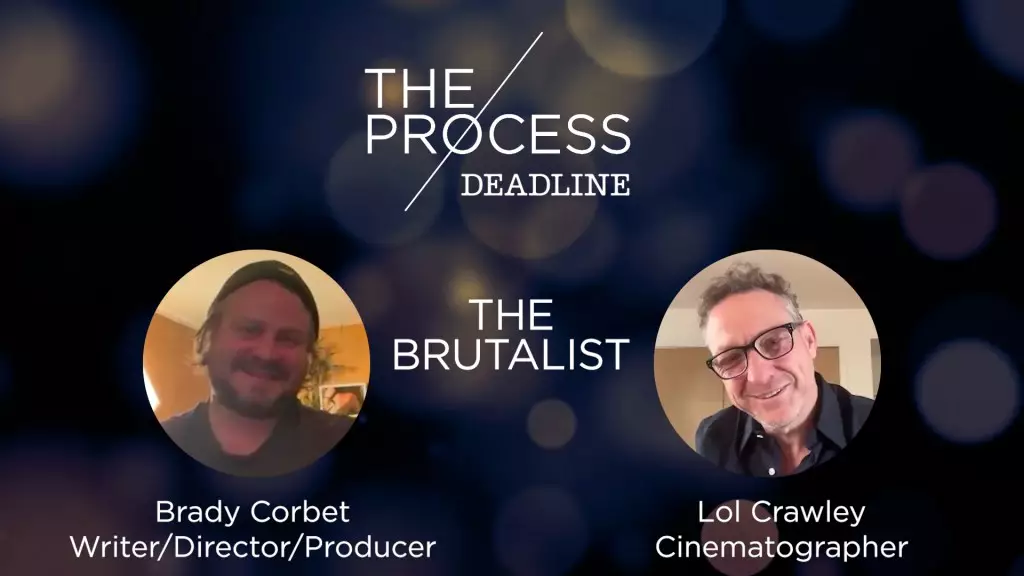The cinematic partnership between Brady Corbet and Lol Crawley is a compelling narrative in the contemporary film landscape. Having previously collaborated on ambitious projects like “Vox Lux” and “The Childhood of a Leader,” the release of “The Brutalist” marks another engaging chapter in their artistic journey. Their synergy, deeply rooted in shared ideals and a mutual understanding of storytelling, illuminates the intricacies of filmmaking as an elaborate tapestry woven with diverse threads. As Corbet reflects on their collaboration, he acknowledges the duality of ambition, describing their work as being perceived through the lenses of both acclaim and criticism—often depending on personal reception.
Corbet conveys a revealing perspective on his creative process, noting a discrepancy between his initial vision and the later expansive world created during production. While he approaches his scripts with a tight focus on character development, the collaborative nature of filmmaking expands these initial ideas into a grand narrative tapestry. Each member of the cast and crew contributes their unique perspective, allowing the film to flourish beyond its original constraints. This acknowledgment of collaborative synergy is crucial, as it highlights the symbiotic relationship between director and cinematographer—each supporting the other to deliver a collective vision that transcends individual perspectives.
The Art of Cinematic Language
Cinematic language is an elusive concept, often discussed yet rarely defined with precision. In their conversation, Crawley emphasizes the cinematographic approach to storytelling, focusing on the intention behind each shot and scene. The ambition behind “The Brutalist” isn’t merely to portray grandeur but rather to evoke emotion through purposeful cinematography. This commentary brings to light the idea that the execution of visually compelling shots harmonizes with the actors’ performances, creating a cohesive language that resonates with the audience. The nuance in their discussion serves not only to define their artistic style but also to elevate the audience’s understanding of cinematic experiences as a blend of visual storytelling and emotional depth.
The duo’s exploration of what constitutes a ‘cinematic’ moment underlines the importance of specificity in filmmaking. Corbet and Crawley articulate the complexity of balancing ambition with artistic integrity, emphasizing that each unique shot carries layers of meaning within its execution. It’s this balance of cinematic artistry and character exploration that invites viewers into the heart of their narratives, allowing them to experience profound emotional arcs even against a backdrop of overarching themes.
While the artistic aspirations are prominent, the gritty reality of film production often lurks beneath the surface. Corbet and Crawley candidly dissect the taxing nature of filming, describing the exhaustion and intensity that come standard with the territory. Their humor regarding the chaotic environment of a film set sheds light on the high-stress nature of the industry, casting it as both rewarding and punishing. For outsiders, the allure of a film set may be intoxicating, but the repetitive, grueling routine they describe can quickly disillusion even the most curious onlooker.
Such honesty about the laborious nature of filmmaking contributes to a more authentic narrative surrounding the profession. It reframes the glamorous perception often held by the public, illustrating a complex landscape rich with talented yet sometimes weary individuals dedicated to a singular vision. In doing so, Corbet’s reflections serve to humanize the craft, reminding audiences that behind every acclaimed film is a collective of passionate, albeit drained, persons contributing their crafts to craft lasting stories.
Set against the tumultuous backdrop of post-World War II, “The Brutalist” tells a poignant tale through the lens of László Tóth, an architect navigating his tumultuous inner and external landscapes. The exploration of his experiences as a Hungarian-Jewish survivor adds a layer of historical depth that resonates with contemporary audiences. Tóth’s ambitious journey of creation in the face of personal and collective trauma emphasizes the transformative power of resilience and creativity.
The film boasts a star-studded cast, with Adrien Brody leading as Tóth, supported by talents like Felicity Jones and Joe Alwyn. This ensemble brings an additional layer of authenticity to the narrative, allowing the audience to connect deeply with the characters’ struggles and triumphs. As Tóth grapples with memories of the Holocaust while forging a new life in America, themes of hope and the pursuit of artistic expression emerge, compelling viewers to reflect on the intricacies of their own narratives.
The industry’s response to “The Brutalist” has been overwhelmingly positive, evidenced by its accolades, including a Golden Globe for Best Motion Picture Drama and numerous Oscar nominations. The critical acclaim reflects a widespread acknowledgment of the film’s artistic merit, compelling performances, and rich storytelling. The film stands as a testament to the collaborative effort cultivated by Corbet and Crawley, leaving audiences eager for the next intersection of their creative visions.
“The Brutalist” rises as a distinctive work within the ever-evolving narrative of cinema. Through its exploration of ambitious creativity, collaborative artistry, and rich storytelling, it underscores the indomitable spirit of filmmaking, suggesting that the process—remarkably messy and often chaotic—can yield profound beauty, mirroring the very narratives it seeks to depict.



Leave a Reply